The post porcelain insulator market is valued at USD 1,486.0 million in 2025 and is projected to reach USD 2,737.6 million by 2035, recording an absolute increase of USD 1,251.6 million. Demand rises to a total growth of 84.2%, with the post porcelain insulator market forecast expected to expand at a CAGR of 6.2% and the post porcelain insulator market size is expected to grow by nearly 1.84X during the period. On the supply side, manufacturers are expanding capacity and modernizing ceramic processing facilities to meet rising global demand. Asia-Pacific, particularly China and India, is emerging as a dominant production hub, benefiting from cost advantages, raw material availability, and large-scale infrastructure expansion. Meanwhile, European and North American producers are prioritizing advanced insulator designs with premium coatings, enhanced dielectric strength, and longer service life, targeting high-value transmission and smart-grid projects. Supply chain strategies are also shifting, with manufacturers securing raw material consistency for kaolin, alumina, and other ceramic inputs to reduce volatility in pricing.
On the demand side, utilities remain the primary consumers, driven by grid modernization, electrification projects, and the expansion of high-voltage transmission infrastructure to support renewable energy integration. Developing economies are leading in new installations, while developed markets prioritize replacement cycles and upgrades for aging infrastructure. Industrial end-users such as oil and gas, mining, and manufacturing facilities are also contributing to demand, focusing on reliable insulation to ensure operational stability. The balance between new installations in emerging economies and replacement demand in mature economies provides stability to long-term growth prospects.
Regionally, Asia-Pacific is expected to contribute the largest share of market expansion, supported by government-led electrification programs, large-scale renewable integration, and investments in high-voltage transmission corridors. North America is forecast to record steady growth due to the modernization of aging grids and investments in smart-grid infrastructure. Europe’s demand will remain closely tied to the integration of renewable energy and adherence to stringent safety and reliability standards. Latin America, the Middle East, and Africa are expected to experience incremental growth, with rural electrification, industrialization, and infrastructure diversification serving as the primary catalysts.
The competitive landscape is characterized by a mix of global leaders focusing on technology-driven premium products and regional manufacturers offering cost-effective alternatives. Companies that can balance price competitiveness with enhanced performance features such as higher mechanical durability, pollution resistance, and online monitoring integration are likely to strengthen their position. Policies supporting renewable integration and infrastructure upgrades, along with international quality and safety standards, further reinforce demand for high-performance insulators.
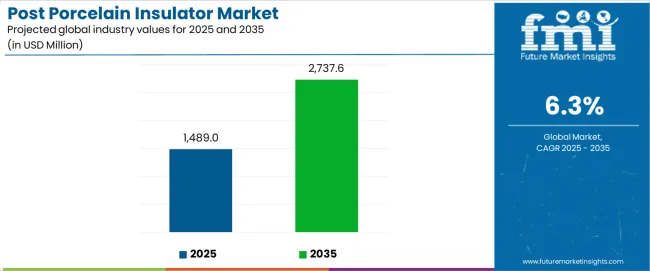
| Period | Primary Revenue Buckets | Share | Notes |
|---|---|---|---|
| Today | Solid type insulators (distribution lines, substations) | 54% | Traditional applications, established utilities |
| Power distribution applications | 46% | Grid infrastructure, transmission lines | |
| Hollow type insulators | 38% | Specialized applications, high-voltage systems | |
| Railways applications | 8% | Electrified rail systems, transport infrastructure | |
| Future (3-5 yrs) | Advanced solid systems | 48-52% | Enhanced dielectric properties, smart grid integration |
| High-voltage distribution | 28-32% | Grid modernization, renewable integration | |
| HVDC transmission applications | 15-18% | Long-distance power transmission, grid interconnection | |
| Smart grid & monitoring | 8-12% | IoT integration, condition monitoring systems | |
| Railway electrification | 6-10% | High-speed rail, urban transit systems | |
| Custom & specialty applications | 4-7% | Offshore wind, industrial applications |
| Metric | Value |
|---|---|
| Market Value (2025) | USD 1,486.0 million |
| Market Forecast (2035) | USD 2,737.6 million |
| Growth Rate | 6.3% CAGR |
| Leading Type | Solid Insulators |
| Primary Application | Power Distribution Segment |
The post porcelain insulator market demonstrates strong fundamentals with solid insulator systems capturing a dominant share through advanced porcelain properties and electrical application optimization. Power distribution applications drive primary demand, supported by increasing grid reliability requirements and electrical infrastructure modernization initiatives. Geographic expansion remains concentrated in developed markets with established electrical infrastructure, while emerging economies show accelerating adoption rates driven by power grid modernization initiatives and rising electrical safety standards.
Primary Classification: The market segments by type into solid, hollow, and others, representing the evolution from traditional porcelain designs to sophisticated insulator configurations for comprehensive electrical infrastructure optimization.
Secondary Classification: Application segmentation divides the post porcelain insulator market into power distribution, railways, HVDC transmission, HVAC transmission, and others, reflecting distinct requirements for electrical performance, voltage ratings, and environmental specifications.
Tertiary Classification: End-use segmentation covers utility companies, electrical contractors, railway operators, industrial facilities, and renewable energy projects, while distribution channels span direct sales, electrical distributors, and specialized power equipment suppliers.
Regional Classification: Geographic distribution covers North America, Latin America, Western Europe, Eastern Europe, East Asia, South Asia Pacific, and Middle East & Africa, with developed markets leading adoption while emerging economies show accelerating growth patterns driven by electrical infrastructure modernization programs.
The segmentation structure reveals type progression from traditional solid insulators toward sophisticated hollow designs with enhanced electrical capabilities, while application diversity spans from power distribution to specialized railway systems requiring precision insulator solutions.
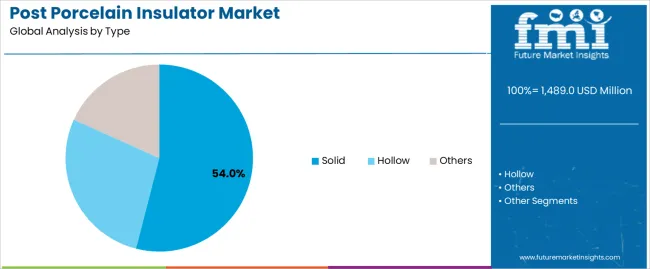
Market Position: Solid insulator systems command the leading position in the post porcelain insulator market with 54% market share through proven porcelain technologies, including superior dielectric properties, mechanical strength optimization, and electrical performance that enable power utilities to achieve optimal grid reliability across diverse distribution and transmission environments.
Value Drivers: The segment benefits from electrical industry preference for traditional insulator systems that provide reliable electrical isolation, mechanical durability, and operational reliability without requiring complex hollow construction infrastructure. Advanced porcelain processing features enable enhanced flashover resistance, pollution performance, and integration with existing electrical systems, where electrical performance and mechanical reliability represent critical operational requirements.
Competitive Advantages: Solid insulator systems differentiate through proven electrical reliability, mechanical strength characteristics, and integration with established grid management systems that enhance facility effectiveness while maintaining optimal electrical safety standards suitable for diverse power applications.
Key market characteristics:
Hollow insulator systems maintain a 38% market position in the post porcelain insulator market due to their specialized advantages and high-voltage positioning benefits. These insulators appeal to facilities requiring advanced electrical solutions with enhanced voltage ratings for transmission applications. Market growth is driven by HVDC system expansion, emphasizing high-performance insulator solutions and electrical efficiency through optimized electrical designs.
Market Context: Power distribution applications demonstrate strong growth in the post porcelain insulator market with 6.8% CAGR due to widespread adoption of grid modernization programs and increasing focus on electrical reliability, operational cost efficiency, and system performance applications that maximize insulator effectiveness while maintaining safety standards.
Appeal Factors: Power utilities prioritize insulator reliability, electrical consistency, and integration with existing grid infrastructure that enables coordinated electrical operations across multiple voltage levels. The segment benefits from substantial electrical infrastructure investment and modernization programs that emphasize the acquisition of premium insulators for grid differentiation and system reliability applications.
Growth Drivers: Grid expansion programs incorporate post insulators as essential components for electrical operations, while smart grid growth increases demand for insulator capabilities that comply with electrical standards and minimize operational complexity.
Market Challenges: Varying voltage requirements and operational scale complexity may limit insulator standardization across different utilities or electrical scenarios.
Application dynamics include:
Railways applications capture 8% market share through specialized electrical requirements in electrified rail systems, high-speed railways, and transportation applications. These facilities demand specialized insulators capable of supporting railway electrical systems while providing reliable electrical isolation and operational durability capabilities.
HVDC transmission applications account for 18% market share, including long-distance transmission, grid interconnection, and renewable energy integration, requiring high-performance insulator capabilities for voltage optimization and electrical effectiveness.
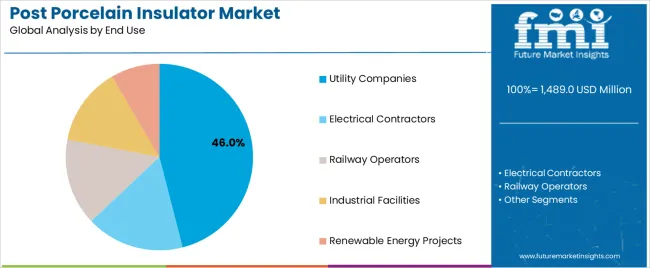
Market Context: Utility Companies dominate the post porcelain insulator market with 6.5% CAGR and 46% market share, reflecting the primary demand source for post porcelain insulator technology in electrical infrastructure applications and grid standardization.
Business Model Advantages: Utility Companies provide direct market demand for standardized insulator systems, driving volume production and cost optimization while maintaining quality control and electrical performance requirements.
Operational Benefits: Utility Company applications include grid standardization, cost efficiency, and reliability assurance that drive consistent demand for insulator systems while providing access to the latest porcelain technologies.
| Category | Factor | Impact | Why It Matters |
|---|---|---|---|
| Driver | Grid modernization & infrastructure expansion (smart grid, renewable integration) | ★★★★★ | Growing electrical infrastructure market requires advanced insulators with enhanced performance capabilities and reliability properties proven effective across power applications. |
| Driver | Electrical safety standards advancement & reliability requirements (grid stability, system protection) | ★★★★★ | Transforms insulator requirements from "basic isolation" to "advanced electrical performance"; utilities that offer quality insulators and compliance features gain a competitive advantage. |
| Driver | HVDC transmission market growth & renewable integration (long-distance transmission, grid interconnection) | ★★★★☆ | HVDC systems need high-performance, specialized insulators; demand for premium and superior insulator solutions is expanding the addressable market. |
| Restraint | Cost pressures & budget constraints (especially for smaller utilities) | ★★★★☆ | Smaller electrical operators defer insulator upgrades; increases price sensitivity and slows premium insulator adoption in cost-conscious markets. |
| Restraint | Alternative insulator technology competition (composite insulators, glass insulators) | ★★★☆☆ | Composite alternatives offer weight advantages and different performance characteristics, potentially limiting porcelain insulator adoption in certain applications. |
| Trend | Porcelain technology integration & performance enhancement (glazing improvement, mechanical optimization) | ★★★★★ | Advanced porcelain properties, electrical optimization, and performance analytics transform operations; technology integration and performance enhancement become core value propositions. |
| Trend | Condition monitoring & smart grid integration (IoT sensors, predictive maintenance) | ★★★★☆ | Smart insulators with monitoring capabilities for specific applications; specialized designs and targeted monitoring capabilities drive competition toward intelligent solutions. |
The post porcelain insulator market demonstrates varied regional dynamics with Growth Leaders including China (8.5% growth rate) and India (7.9% growth rate) driving expansion through electrical infrastructure development initiatives and power grid modernization. Steady Performers encompass Germany (7.2% growth rate), Brazil (6.6% growth rate), and developed regions, benefiting from established electrical industries and advanced insulator adoption. Mature Markets feature United States (6.0% growth rate), United Kingdom (5.4% growth rate), and Japan (4.7% growth rate), where grid advancement and electrical standardization requirements support consistent growth patterns.
Regional synthesis reveals East Asian markets leading adoption through electrical infrastructure expansion and power grid development, while North American countries maintain steady expansion supported by insulator technology advancement and electrical standardization requirements. European markets show strong growth driven by grid applications and reliability integration trends.
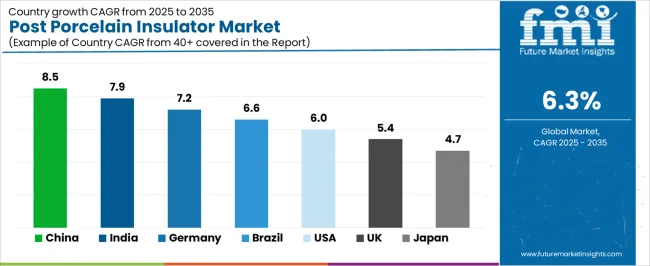
| Region/Country | 2025-2035 Growth | How to win | What to watch out |
|---|---|---|---|
| China | 8.5% | Focus on volume production solutions | Regulatory changes; local competition |
| India | 7.9% | Lead with cost-effective manufacturing | Import restrictions; quality barriers |
| Germany | 7.2% | Provide premium quality insulators | Over-regulation; lengthy approvals |
| Brazil | 6.6% | Offer value-oriented solutions | Currency fluctuations; import duties |
| United States | 6.0% | Push technology integration | Compliance costs; scaling challenges |
| United Kingdom | 5.4% | Focus on premium applications | Economic impacts; insulator costs |
| Japan | 4.7% | Emphasize quality manufacturing | Traditional preferences; adoption rates |
China establishes fastest market growth through aggressive electrical infrastructure development programs and comprehensive power grid expansion, integrating advanced post porcelain insulator systems as standard components in transmission facilities and distribution installations. The country's 8.5% growth rate reflects government initiatives promoting electrical infrastructure and domestic insulator capabilities that mandate the use of advanced insulator systems in power grid and transmission facilities. Growth concentrates in major electrical hubs, including Beijing, Shanghai, and Guangzhou, where grid development showcases integrated insulator systems that appeal to power operators seeking electrical performance optimization capabilities and operational applications.
Chinese manufacturers are developing cost-effective insulator solutions that combine domestic production advantages with advanced porcelain features, including enhanced electrical control and improved mechanical capabilities. Distribution channels through electrical suppliers and power equipment distributors expand market access, while government support for grid development supports adoption across diverse transmission and distribution segments.
Strategic Market Indicators:
In Mumbai, Delhi, and Bangalore, power facilities and electrical operators are implementing advanced post porcelain insulator systems as standard equipment for grid reliability and electrical optimization applications, driven by increasing government electrical investment and infrastructure modernization programs that emphasize the importance of electrical performance capabilities. The post porcelain insulator market holds a 7.9% growth rate, supported by government electrical initiatives and grid development programs that promote advanced insulator systems for power and transmission facilities. Indian operators are adopting insulator systems that provide consistent electrical performance and reliability features, particularly appealing in urban regions where grid reliability and electrical excellence represent critical business requirements.
Market expansion benefits from growing electrical capabilities and international power partnerships that enable domestic production of advanced insulator systems for power and transmission applications. Technology adoption follows patterns established in electrical equipment, where reliability and performance drive procurement decisions and operational deployment.
Market Intelligence Brief:
Germany's advanced electrical market demonstrates sophisticated post porcelain insulator deployment with documented electrical effectiveness in power applications and transmission facilities through integration with existing electrical systems and operational infrastructure. The country leverages engineering expertise in porcelain and electrical systems integration to maintain a 7.2% growth rate. Electrical centers, including Bavaria, Baden-Württemberg, and North Rhine-Westphalia, showcase premium installations where insulator systems integrate with comprehensive electrical platforms and facility management systems to optimize grid performance and electrical effectiveness.
German manufacturers prioritize system quality and EU compliance in insulator development, creating demand for premium systems with advanced features, including facility integration and electrical performance systems. The post porcelain insulator market benefits from established electrical infrastructure and a willingness to invest in advanced insulator technologies that provide long-term operational benefits and compliance with international electrical standards.
Market Intelligence Brief:
Brazil's market expansion benefits from diverse electrical demand, including infrastructure modernization in Rio de Janeiro and São Paulo, power facility upgrades, and government electrical programs that increasingly incorporate advanced insulator solutions for grid applications. The country maintains a 6.6% growth rate, driven by rising electrical activity and increasing recognition of advanced insulator benefits, including precise electrical control and enhanced operational effectiveness.
Market dynamics focus on cost-effective insulator solutions that balance electrical performance with affordability considerations important to Brazilian electrical operators. Growing electrical industrialization creates continued demand for modern insulator systems in new electrical infrastructure and facility modernization projects.
Strategic Market Considerations:
United States establishes market leadership through comprehensive electrical programs and advanced power infrastructure development, integrating post porcelain insulator systems across transmission and distribution applications. The country's 6.0% growth rate reflects established electrical industry relationships and mature insulator technology adoption that supports widespread use of advanced insulator systems in power and transmission facilities. Growth concentrates in major electrical centers, including California, Texas, and New York, where insulator technology showcases mature deployment that appeals to electrical operators seeking proven performance capabilities and operational efficiency applications.
American electrical providers leverage established distribution networks and comprehensive technical support capabilities, including testing programs and training support that create customer relationships and operational advantages. The post porcelain insulator market benefits from mature regulatory standards and electrical requirements that mandate insulator system use while supporting technology advancement and operational optimization.
Market Intelligence Brief:
United Kingdom's electrical market demonstrates integrated post porcelain insulator deployment with documented electrical effectiveness in power applications and transmission facilities through integration with existing electrical systems and operational infrastructure. The country maintains a 5.4% growth rate, supported by electrical excellence programs and performance effectiveness requirements that promote advanced insulator systems for electrical applications. Power facilities across England, Scotland, and Wales showcase systematic installations where insulator systems integrate with comprehensive electrical platforms to optimize grid performance and electrical outcomes.
UK electrical providers prioritize system reliability and industry compatibility in insulator procurement, creating demand for validated systems with proven electrical features, including performance monitoring integration and electrical performance systems. The post porcelain insulator market benefits from established electrical infrastructure and excellence requirements that support insulator technology adoption and electrical effectiveness.
Market Intelligence Brief:
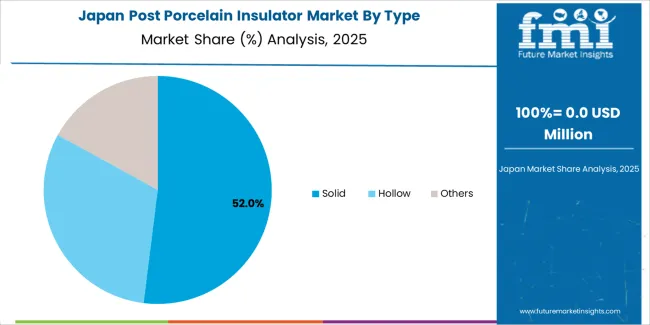
Japan's market growth benefits from precision electrical demand, including advanced power facilities in Tokyo and Osaka, quality integration, and performance enhancement programs that increasingly incorporate insulator solutions for electrical applications. The country maintains a 4.7% growth rate, driven by electrical technology advancement and increasing recognition of precision insulator benefits, including accurate electrical control and enhanced performance outcomes.
Market dynamics focus on high-precision insulator solutions that meet Japanese quality standards and electrical effectiveness requirements important to electrical operators. Advanced electrical technology adoption creates continued demand for sophisticated insulator systems in power facility infrastructure and electrical modernization projects.
Strategic Market Considerations:
The European post porcelain insulator market is projected to grow from USD 298.7 million in 2025 to USD 547.5 million by 2035, registering a CAGR of 6.2% over the forecast period. Germany is expected to maintain its leadership position with a 42.1% market share in 2025, supported by its advanced electrical infrastructure and major power centers.
United Kingdom follows with a 23.8% share in 2025, driven by comprehensive electrical programs and grid excellence development initiatives. France holds a 16.2% share through specialized electrical applications and power compliance requirements. Italy commands a 10.7% share, while Spain accounts for 4.9% in 2025. The rest of Europe region is anticipated to gain momentum, expanding its collective share from 2.3% to 2.6% by 2035, attributed to increasing electrical adoption in Nordic countries and emerging power facilities implementing electrical modernization programs.
| Stakeholder | What they actually control | Typical strengths | Typical blind spots |
|---|---|---|---|
| Global brands | Manufacturing capacity, broad product portfolios, brand recognition | Wide availability, proven quality, multi-region support | Product refresh cycles; customer dependency on brand validation |
| Technology innovators | Porcelain R&D; advanced material technologies; enhanced electrical properties | Latest technologies first; attractive ROI on electrical effectiveness | Service density outside core regions; scaling complexity |
| Regional specialists | Local compliance, fast delivery, nearby customer support | "Close to customer" support; pragmatic pricing; local regulations | Technology gaps; talent retention in customer service |
| Full-service providers | Insulator programs, testing services, condition monitoring | Lowest operational risk; comprehensive support | Service costs if overpromised; technology obsolescence |
| Niche specialists | Specialized applications, custom insulators, technical services | Win premium applications; flexible configurations | Scalability limitations; narrow market focus |
| Item | Value |
|---|---|
| Quantitative Units | USD 1,486.0 million |
| Type | Solid, Hollow, Others |
| Application | Power Distribution, Railways, HVDC Transmission, HVAC Transmission, Others |
| End Use | Utility Companies, Electrical Contractors, Railway Operators, Industrial Facilities, Renewable Energy Projects |
| Regions Covered | North America, Latin America, Western Europe, Eastern Europe, East Asia, South Asia Pacific, Middle East & Africa |
| Countries Covered | China, India, Germany, Brazil, United States, United Kingdom, Japan, Canada, France, Australia, and 25+ additional countries |
| Key Companies Profiled | Seves Group, Hunan Yangdong Porcelain Insulators&Electric, Reinhausen, Huayang Electric, SAA Grid Technology, NGK Insulators, LAPP Insulators, PPC Insulators |
| Additional Attributes | Dollar sales by type and application categories, regional adoption trends across East Asia, North America, and Western Europe, competitive landscape with porcelain manufacturers and electrical suppliers, utility operator preferences for insulator effectiveness and electrical performance, integration with electrical platforms and grid management systems, innovations in porcelain technology and insulator enhancement, and development of advanced insulator solutions with enhanced electrical performance and operational optimization capabilities. |
The global post porcelain insulator market is estimated to be valued at USD 1,489.0 million in 2025.
The market size for the post porcelain insulator market is projected to reach USD 2,737.6 million by 2035.
The post porcelain insulator market is expected to grow at a 6.3% CAGR between 2025 and 2035.
The key product types in post porcelain insulator market are solid , hollow and others.
In terms of end use, utility companies segment to command 46.0% share in the post porcelain insulator market in 2025.






Full Research Suite comprises of:
Market outlook & trends analysis
Interviews & case studies
Strategic recommendations
Vendor profiles & capabilities analysis
5-year forecasts
8 regions and 60+ country-level data splits
Market segment data splits
12 months of continuous data updates
DELIVERED AS:
PDF EXCEL ONLINE
Line Post Porcelain Insulator Market Size and Share Forecast Outlook 2025 to 2035
Post-Operative Wound Treatment Market Size and Share Forecast Outlook 2025 to 2035
Post Harvesting Technologies Market Size and Share Forecast Outlook 2025 to 2035
Post-Surgery Skin Repair Market Analysis - Size and Share Forecast Outlook 2025 to 2035
Postpartum Health Supplements Market Size and Share Forecast Outlook 2025 to 2035
Post-Operative Cataract Surgery Inflammation Treatment Market Size and Share Forecast Outlook 2025 to 2035
Post-Quantum Cryptography (PQC) Migration Market Analysis - Size, Share, and Forecast Outlook 2025 to 2035
Post-Traumatic Stress Disorder (PTSD) Treatment Market Size and Share Forecast Outlook 2025 to 2035
Postoperative Nausea and Vomiting (PONV) Management Market Size and Share Forecast Outlook 2025 to 2035
Postbiotic Feed Additives Market Analysis - Size and Share Forecast Outlook 2025 to 2035
Post Shave Care Products Market Size and Share Forecast Outlook 2025 to 2035
Postbiotic Supplements Market Analysis - Size, Share, and Forecast Outlook 2025 to 2035
Postpartum Depression Management Market Size and Share Forecast Outlook 2025 to 2035
Postnatal Probiotic Supplements Market Size and Share Forecast Outlook 2025 to 2035
Postoperative Pain Market Size and Share Forecast Outlook 2025 to 2035
Postal Automation Systems Market Size and Share Forecast Outlook 2025 to 2035
Post-Harvest Treatment Market Size and Share Forecast Outlook 2025 to 2035
Post-Consumer Recycled (PCR) Plastic Packaging Market Analysis Size, Share & Forecast 2025 to 2035
Posture Correction Market Size and Share Forecast Outlook 2025 to 2035
Postage Stamp Paper Market Size, Share & Forecast 2025 to 2035

Thank you!
You will receive an email from our Business Development Manager. Please be sure to check your SPAM/JUNK folder too.
Chat With
MaRIA